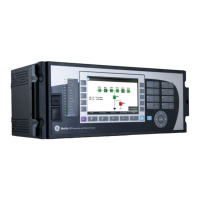5-344 D60 Line Distance Protection System GE Multilin
5.7 CONTROL ELEMENTS 5 SETTINGS
5
• LINE END OPEN PICKUP DELAY: This setting defines the pickup value for validation of the line end open conditions
as detected by the line pickup logic via the LINE PICKUP LEO PKP FlexLogic operand. The validated line end open con-
dition is a requirement for the directional comparison unblocking scheme to return a received echo signal (if the echo
feature is enabled).
The value of this setting should take into account the principle of operation and settings of the line pickup element,
which should thus be enabled.
• DCUB LOG PICKUP DELAY: This setting represents the directional comparison unblocking duration time delay, and is
the amount of time that the loss-of-guard without receipt of permissive trip must be present before the logic provides
permission to operate if a forward fault is detected. It is set relatively short, but long enough to ride through the transi-
tion period of loss-of-guard with the receipt of a permissive signal that occurs with a normal trip. Typical setting values
are from 4 to 32 ms. For most cases, a value of 8 ms may be used.
The tripping or unblocking window for loss-of-guard without permission is the difference between the
DCUB LOG TRIP
WINDOW and DCUB LOG PICKUP DELAY timers. For the default settings, this difference is 150 – 8 = 142 ms and occurs
8 ms after loss-of-guard was received, when the DCUB LOG PICKUP DELAY timer has timed out. During this interval, the
scheme has permission to operate if a forward fault is sensed, and no reverse faults or transient blocking.
• GUARD HEALTHY RESET DELAY: This setting represents the guard healthy security time delay, and is the time after
the channel is restored that the guard signal must be present before the directional comparison unblocking scheme is
put back in service. This reset timer allows the scheme to ride through any chattering in the channel. Typical values are
from 100 to 500 ms, with a value of 150 ms commonly used.
• DCUB LOG TRIP WINDOW: This setting represents the directional comparison unblocking lockout time delay, and is
the amount of time from when any loss-of-guard signal is received until the directional comparison unblocking scheme
is locked out without the presence of any
RX1 to RX4 receive signal or any forward element. This timer seals-in when it
expires, creating a blocking signal for all scheme functions and disabling the scheme until the guard signal is restored
and the GUARD HEALTHY RESET DELAY timer expires. Typical values for this setting are from 160 to 180 ms; for most
cases, a setting of about 150 ms may be used.
• DCUB SEAL-IN DELAY: The output FlexLogic operand (DCUB OP) is produced according to the directional compari-
son unblocking scheme logic. The
DCUB SEAL-IN DELAY defines a minimum guaranteed duration of the DCUB OP pulse.
As this operand runs the trip table of the directional comparison unblocking scheme, the DCUB TRIP A, DCUB TRIP B,
DCUB TRIP C, and DCUB TRIP 3P trip operands are sealed-in for the same period of time.
• DCUB NO OF COMM BITS: This setting specifies the number of bits available on the communications channel for the
scheme. With only one bit available, the scheme sends the direct under-reaching transfer trip command on bit 1 (DCUB
TX1
operand) and responds to the direct trip command received on bit 1 (DCUB RX1 setting). The scheme uses only
local fault type identification provided by the phase selector to assert the DCUB TRIP A, DCUB TRIP B, DCUB TRIP C and
DCUB TRIP 3P output operands (see Chapter 8: Theory of Operation for details on the use of communication channels).
• DCUB RX1 through DCUB RX4: These settings allow the user to select the FlexLogic operands to represent the per-
mission receive signals for the scheme. Contact inputs interfacing with a signaling system(s) are typically used. These
settings must be used in conjunction with the loss-of-guard signals, otherwise the scheme will not unblock and thus fail
to operate.
In single-bit applications,
DCUB RX1 must be used. In two-bit applications, DCUB RX1 and DCUB RX2 must be used. In
four-bit applications,
DCUB RX1, DCUB RX2, DCUB RX3, and DCUB RX4 must be used.
• DCUB LOG1 through DCUB LOG4: These settings allow the user to select the FlexLogic operands to represent the
loss-of-guard receive signals for the scheme. Contact inputs interfacing with a signaling system(s) are typically used.
Each loss-of-guard signal must correspond to the same receive signal from the same communications channel (that is,
RX1 and LOG1 must be from the same communications channel, and the same for channels 2, 3 and 4, if used).
In single-bit applications,
DCUB RX1 and DCUB LOG1 must be used. In two-bit applications, DCUB RX1 with DCUB LOG1
and DCUB RX2 with DCUB LOG2 must be used. In four-bit applications, all receive and loss-of-guard signals must be
used.

